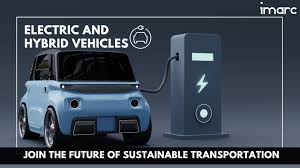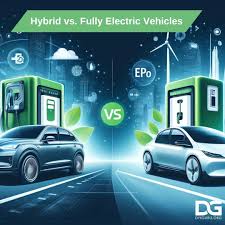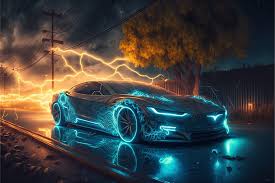FUTURE OF ELECTRIC AND HYBRID CARS 
The future of electric and hybrid cars is a rapidly evolving narrative that encompasses technological advancements, environmental considerations, market dynamics, and consumer preferences. As the world grapples with the effects of climate change and seeks sustainable solutions, the automotive industry is undergoing a transformative shift toward electrification. This exploration delves into various dimensions of this future, including technological developments, market trends, infrastructure challenges, regulatory frameworks, and societal impacts.
Technological Advancements
Battery Technology
One of the most critical components driving the future of electric and hybrid vehicles (EVs) is battery technology. Currently, lithium-ion batteries dominate the market, but research is advancing toward alternatives like solid-state batteries, which promise higher energy densities, faster charging times, and improved safety. Innovations in battery recycling and second-life applications are also gaining traction, helping to mitigate environmental concerns associated with battery disposal.
Charging Infrastructure
The expansion of charging infrastructure is vital for the widespread adoption of EVs. Fast-charging stations are becoming increasingly common, with companies and governments investing heavily in networks to support long-distance travel. Wireless charging technology and ultra-fast chargers capable of delivering significant range in minutes are on the horizon, enhancing convenience for users.
Vehicle Automation
The integration of electric and hybrid vehicles with autonomous driving technology is another area of exciting development. Many EV manufacturers are actively working on self-driving capabilities, which could revolutionize urban mobility. Autonomous electric vehicles could reduce traffic congestion, lower emissions, and offer new modes of transportation.
Market Dynamics
Consumer Demand
Consumer attitudes toward electric and hybrid vehicles are shifting significantly. With growing environmental awareness, many buyers are actively seeking sustainable transportation options. Incentives such as tax credits, rebates, and access to carpool lanes further encourage EV adoption. Additionally, as manufacturers roll out more models across various segments, consumers have increasingly diverse choices, from compact cars to SUVs and trucks.
Competition Among Manufacturers
The automotive industry is witnessing intense competition as traditional automakers and new entrants vie for market share. Established brands are electrifying their fleets, while startups focus exclusively on electric models. This competition is driving innovation and pushing prices down, making EVs more accessible to the average consumer.
Environmental Considerations
Emission Reductions
The transition to electric and hybrid vehicles plays a crucial role in reducing greenhouse gas emissions. Studies indicate that EVs produce fewer emissions over their lifecycle compared to traditional internal combustion engine vehicles, even when accounting for the emissions associated with electricity generation. As renewable energy sources like wind and solar become more prevalent, the carbon footprint of charging EVs continues to decrease.
Sustainable Manufacturing
The automotive industry is also exploring sustainable manufacturing practices. Efforts are underway to reduce the environmental impact of raw material extraction for batteries, improve energy efficiency in production processes, and implement recycling initiatives. Brands committed to sustainability are gaining favor among environmentally conscious consumers, further fueling the shift toward electrification.
Infrastructure Challenges
Charging Network Expansion
Despite advancements, the charging infrastructure still faces challenges. In many regions, the availability of charging stations is insufficient to meet the growing demand for EVs. Urban areas may have relatively better coverage, but rural regions often lag behind. Governments and private companies must collaborate to expand charging networks and ensure equitable access to charging facilities.
Grid Capacity and Stability
The increased demand for electricity from widespread EV adoption poses challenges for existing power grids. Utilities will need to invest in grid upgrades to accommodate the additional load while maintaining stability. Smart grid technologies, which allow for better energy management and integration of renewable sources, will play a crucial role in addressing these challenges.
Regulatory Frameworks
Government Policies
Governments worldwide are implementing policies to promote the adoption of electric and hybrid vehicles. These policies range from stringent emissions standards and fuel economy regulations to ambitious targets for phasing out internal combustion engine vehicles. For example, several countries aim to ban the sale of new gasoline and diesel cars by 2030 or 2040, providing a clear signal to consumers and manufacturers about the future direction of the automotive market.
Incentives and Subsidies
Financial incentives, such as tax breaks and rebates for EV purchases, are pivotal in encouraging consumer adoption. Many regions also offer grants for charging infrastructure development, making it easier for businesses and homeowners to install charging stations. These supportive measures are essential for accelerating the transition to electric mobility.
Societal Impacts
Job Creation and Workforce Transition
The shift toward electric and hybrid vehicles will inevitably impact the workforce. While traditional automotive manufacturing jobs may decline, new opportunities will arise in EV production, battery manufacturing, and charging infrastructure development. Workforce training and reskilling initiatives will be necessary to prepare workers for these changes.
Urban Mobility and Public Transportation
Electric and hybrid vehicles will influence urban mobility strategies. As cities prioritize sustainability, we may see increased investment in electric public transportation options, such as buses and trams. Additionally, ride-sharing services using electric vehicles could become more prevalent, providing convenient alternatives to private car ownership.
Conclusion
The future of electric and hybrid cars is poised for significant growth and transformation. As technological advancements continue to emerge, consumer demand rises, and regulatory frameworks evolve, the automotive landscape will undoubtedly shift toward greater electrification. The convergence of these factors not only addresses environmental concerns but also creates new economic opportunities and societal benefits.
However, challenges remain, particularly regarding charging infrastructure and grid capacity. Addressing these issues will require collaboration among governments, manufacturers, and stakeholders in the energy sector. As we look ahead, the transition to electric and hybrid vehicles represents a crucial step toward a more sustainable and resilient transportation future, fundamentally reshaping the way we move and interact with our environment.
The road to widespread EV adoption is complex, but with concerted effort and innovation, the vision of cleaner, more efficient transportation is well within reach.

